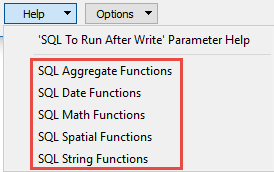Database Connections
|
Database formats include a Database Connection parameter that defines and stores authentication information. For general information about sharing database connections, please see Using Database Connections. Note that Database Connection parameters may differ slightly, depending on context and/or database format. |
Select an existing connection, or Add Database Connection to define a new connection.
The new connection can be made visible only to the current user, or can be shared among multiple users.
Connection Parameters
The host name of the SAP HANA database.
The port of the SAP HANA database.
Typically, this is 3<instance id>15. For example, instance ID 00 would have a port of 30015 and instance ID 90 would have a port of 39015.
In a multiple-database environment, the name of the database to connect to.
Enter the username and password to access the service.
Note: This parameter is not present in the Cloud Platform HANA Service Reader and Writer. The Cloud Platform HANA Service Reader and Writer will always request Secure Sockets Layer (SSL) encrypted connections.
When enabled, this parameter requests encryption for the connection. If the server does not have a certificate trusted by the client machine, the connection will fail. Otherwise, data will be encrypted before traveling over the network.
If this parameter is not enabled, data will not be encrypted over the network and the host certificate will not be validated.
Advanced
How many features will be processed in each transaction.
This parameter defines the time, in seconds, after which a query will be terminated if it has not yet returned a result.
If set to 0, there is no timeout.
This parameter allows for the execution of SQL statements before opening a table for writing. For example, it may be necessary to drop a constraint before attempting to write to it. The statements will be executed only when the first feature arrives at the writer.
For detailed information about SQL functions, click the corresponding menu item in the .
Available menu options depend on the format.
Multiple SQL commands can be delimited by a character specified using the FME_SQL_DELIMITER directive, embedded at the beginning of the SQL block. The single character following this directive will be used to split the SQL block into SQL statements, which will then be sent to the database for execution. Note: Include a space before the character.
For example:
FME_SQL_DELIMITER ; DELETE FROM instructors ; DELETE FROM people WHERE LastName='Doe' AND FirstName='John'
Multiple delimiters are not allowed and the delimiter character will be stripped before being sent to the database.
Any errors occurring during the execution of these SQL statements will normally terminate the reader or writer (depending on where the SQL statement is executed) with an error. If the specified statement is preceded by a hyphen (“-”), such errors are ignored.
This parameter allows for the execution of SQL statements after a set of tables has been written. For example, it may be necessary to clean up a temporary view after creating it.
For detailed information about SQL functions, click the corresponding menu item in the .
Available menu options depend on the format.
Multiple SQL commands can be delimited by a character specified using the FME_SQL_DELIMITER directive, embedded at the beginning of the SQL block. The single character following this directive will be used to split the SQL block into SQL statements, which will then be sent to the database for execution. Note: Include a space before the character.
For example:
FME_SQL_DELIMITER ; DELETE FROM instructors ; DELETE FROM people WHERE LastName='Doe' AND FirstName='John'
Multiple delimiters are not allowed and the delimiter character will be stripped before being sent to the database.
Any errors occurring during the execution of these SQL statements will normally terminate the reader or writer (depending on where the SQL statement is executed) with an error. If the specified statement is preceded by a hyphen (“-”), such errors are ignored.
